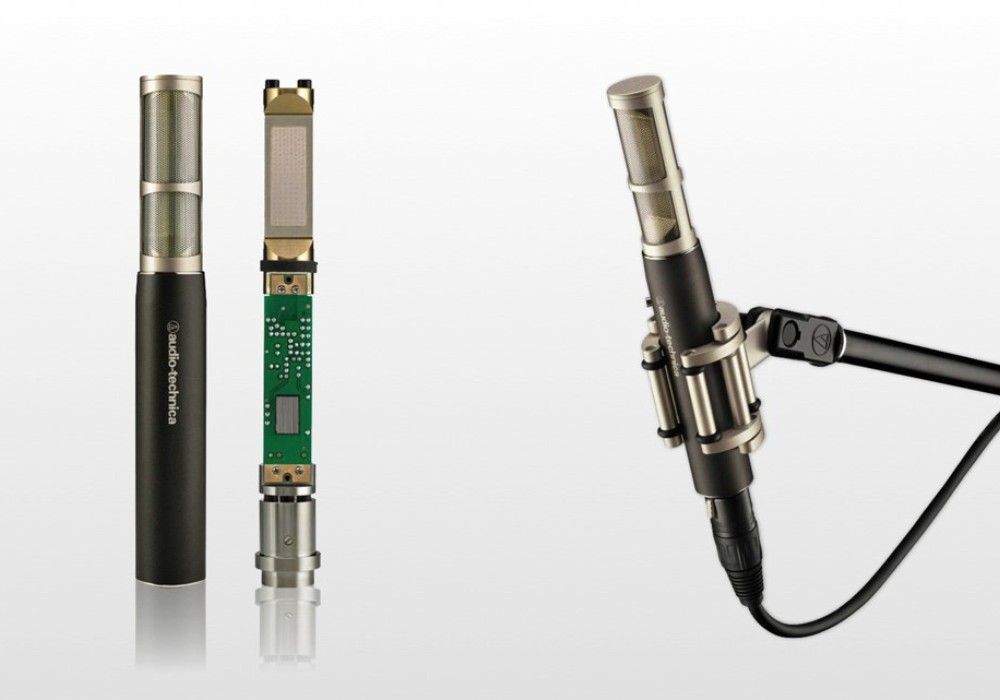The Nady RSM-2 is the latest entry into the field of inexpensive Chinese mics. Asian-made condensers have been on the market now for several years, so it was inevitable, given the retro craze in today's recording studios, that we would see Chinese ribbon mics hit our shores. At a street price below $300, a ribbon mic is now affordable for even the lowest budget studio.
The first thing I noticed when unpacking the mic was the manual! I was immediately greeted by a stern warning about the need to read the manual. Manuals for mics are generally some basic stats and facts. But, this being a ribbon, I was curious about whether or not it could handle phantom power, and so I read the single page printout completely on both sides. I was a little suspicious when the document proclaimed "since the ribbon assembly of the RSM-2, as with all ribbon microphones, is extremely fragile, you must verify immediately upon receipt of your microphone that it has not been damaged during shipment and is operating correctly. The warranty on this microphone does not extend beyond an initial inspection, since these microphones can be so easy damaged during handling and use." I don't remember seeing that disclaimer from the other ribbons I own. In fact, by the time I finished reading the manual, I discovered no fewer than twelve references to ways you can destroy or otherwise damage the ribbon. These included the aforementioned "phantom power is a no-no" (sic), as well as air and percussive sound blasts, and even storing the mic in a horizontal position for an extended length of time.
Negative warnings aside, the manual serves as a good primer to those who are handling a ribbon mic for the first time. The mic comes in a padded cloth bag. Nady recommends that you use the bag as a dust cover when you store the mic in the recommended vertical position.
Removing the mic from the bag revealed an RCA 77 style microphone with a shiny gold grill. (A platinum finish is also available.) After carefully inspecting it for damage, I proceeded to mount the mic on a stand. At a little over three pounds, you should definitely put this on a sturdy stand. Seeing the mic on the stand made me want to start singing doo-wop right away.
I like ribbon mics a lot. I love the way things recorded in figure-eight sound. Ribbons have such a great nulling capability of off-axis sounds, so I figured I'd try this mic on the things I like to use my ribbons on. The first thing I tried the RSM-2 on was an acoustic guitar. I positioned the mic about a foot away, aimed it where the neck meets the body, and hooked it up to an LA-610. As I expected, for a new mic, it sounded kind of old. The magnets on this mic are extremely small, and obviously the ribbon is very thin. It sounded very much like a vintage American ribbon that I have, minus the ground hum.
Next, I tried it as a room mic on a basic tracking session. I put it in a spot roughly centered in the room to take advantage of the figure-eight pattern of the mic. This time, however, I hooked it up to an old Ampex preamp that we have. This yielded great results, as the microphone's inherent lo-fi character delivered the smoky sound that I was looking for. Heeding the dire warnings from the manual, I was hesitant to use it on a loud guitar cabinet that I knew would generate some low-end air pushes. I did, however, try it on some guitar played though a small Gretsch amp that is about five Watts with 6-inch speakers. I really enjoyed how the Nady added to the insane, transistorized sound that we were going for.
Of course, I had to try it on some vocals. The sound of a ribbon mic for lead vocals takes some getting used to when all you are accustomed to hearing is the modern condenser vocal sound. Since ribbon mics were the predominant microphone in the audio industry's early days, there is a deceptively natural sound to a ribbon on a lead vocal. Perhaps the sound is too natural for many modern ears to accept. There's nothing like the vocal sound of a good RCA ribbon, but this isn't quite it. I was hoping to discover a $350 RCA 77, and, admittedly, my expectations were a bit lofty. Given how small the magnets and ribbon elements are compared to those classic monsters of yesteryear, you shouldn't expect this microphone to sound that way.
Companies like AEA and Royer use healthy ribbon stock and beefy magnets. So, on critical applications like vocals, the inexpensiveness of this microphone was noticeable. Even with pop filters, it was difficult to avoid some untimely thumping. The remedy for this was to place the mic further away from the vocalist, and at a lower height. I decided to give the vocalist a normal condenser setup so they were comfortable, and then I moved the ribbon mic about two feet away. I put the ribbon on another channel and fed the condenser mic into the singer's headphones. This created more of an affected vocal sound, which we could use if we decided to get "gimmicky" on the chorus.
We explored the chorus idea more by using the mic on two people singing backing vocals simultaneously, positioned on both sides of the mic. This track, combined with the lead vocal track, created a lush, open-air, "old- timey" sound. Imagine that.
In my opinion, ribbon mics require you to be more creative in your recording and, when used properly, provide a nice complement to all of your close mic'ing. A nice thing about the Nady RSM-2 is that it's so affordable that there's no excuse for you not to buy one and get bitten by the ribbon bug. Musicians ask me all the time what kind of mics they should get for their home recording setup. It's nice to be able to recommend an affordable ribbon that, when they blow it up, will only set them back $300. A low-cost mic of any kind that adds a different color to your recordings is always a good thing. Why not make it a ribbon?
($349.95 MSRP; www.nady.com)





_disp_horizontal_bw.jpg)